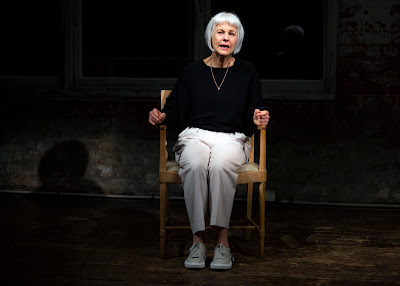Girl From The North Country. Presented by GWB Entertainment, Damien Hewitt and Trafalgar Entertainment in association with Canberra Theatre Centre, August 25 – September 3, 2022.
Reviewed by Frank McKone, August 26
Creatives: reproduced below. Original production opened at The Old Vic, London, 2017.
Cast - Australia (alphabetical order):
Mr Perry – Peter Carroll; Dr Walker – Terence Crawford
Mrs Burke – Helen Dallimore; Elias Burke – Blake Erikson
Katherine Draper – Elizabeth Hay; Nick Laine – Peter Kowitz
Elizabeth Laine – Lise McCune; Mrs Neilsen – Christina O’Neill
Reverend Marlow – Grant Piro; Gene Laine – James Smith
Mr Burke – Greg Stone; Marianne Laine – Chemon Theys
Joe Scott – Elijah Williams
Ensemble – Tony Black, Tony Cogin, Laurence Coy, Grace Driscoll,
Samantha Morley, Liam Wigney
Band
Musical Director – Andrew Ross; Acoustic and Slide Guitar – Cameron Henderson
Bass – James Luke; Violin and Mandolin – Pip Thompson
 | |
| Peter Carroll as Mr Perry in Girl From The North Country Australian Tour 2022 |
Girl From The North Country
is about failure – economic failure; failure to find love (Mr Perry,
Joe Scott, the Laine family and Mrs Burke at least); social collapse.
The play has no plot because when “The Depression grabbed hold of
Minnesota” the people’s lives, as presented by Conor McPherson, had
nowhere to go “Like a Rolling Stone”.
There is a beginning as
Nick Laine offers rooms; and an end as people who stayed there had no
choice but to move on – without the money to pay Nick. According to Dr
Walker, the narrator of these sad times, Nick and his demented wife
Elizabeth themselves left Minnesota as the bank foreclosed on their
house.
The structure of the play is actually rather like Bertolt Brecht’s Mother Courage and her Children.
Episodes are interrupted by songs, which, often in an oblique way,
reflect on social, even political, life. Here, though, characters sing
songs by Bob Dylan as if still in role in the American Musical
tradition. The distancing effect is rather less, then, than the
estrangement effect (Verfremdungseffekt or V-Effekt) in Brecht’s work.
In
addition the movement choreography and dance sequences (highly original
and performed by the whole cast with great flair) become fascinating
entertainment in their own right.
So I find myself in two minds about the purpose of Girl From The North Country.
Am I to become empathetically engaged in the dreadful state of the
lives of these people; or am I to take Bob Dylan’s songs as the focus
for the criticism of American life, in the rather dry, almost cynical
mood that I remember so well from his early songs when still in his
acoustic folk-scene stage?
Though I marvel at the quality of
the acting, singing, music performance and strength of theatre design,
my two minds remain divergent rather than finding a composite resolution
which might turn this ‘Art Musical’ into a great and powerful work of
art. I note that Conor McPherson began writing “I’m thinking of an
expansive Eugene O’Neill type play with Bob Dylan’s love songs
intertwined”. A great idea I think, but I have to say in return that Girl From The North Country is no match for Mourning Becomes Electra.
© Frank McKone, Canberra











